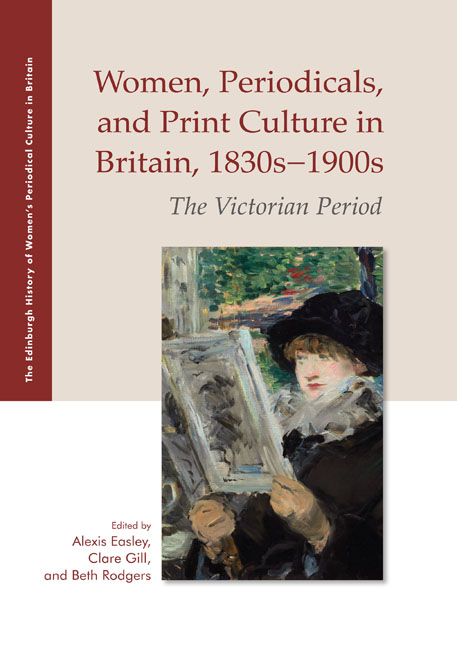Book contents
- Frontmatter
- Contents
- List of Illustrations
- Acknowledgments
- Introduction: Women, Periodicals, and Print Culture in the Victorian Period
- Part I (Re)Imagining Domestic Life
- Part II Constructing Modern Girls and Young Women
- Part III Women and Visual Culture
- Part IV Making Space for Women
- Part V Constructing Women Readers and Writers
- Part VI Intervening in Political Debates
- Intervening in Political Debates: Introduction
- 30 Brewing Storms of War, Slavery, and Imperialism: Harriet Martineau's Engagement with the Periodical Press
- 31 Mary Smith (1822–1889): A Radical Journalist under Many Guises
- 32 In Time of Disturbance: Political Dissonance and Subversion in Violet Fane's Contributions to the Lady's Realm
- 33 ‘Our Women in Journalism’: African-American Women Journalists and the Circulation of News
- 34 The Response of the Late Victorian Feminist Press to Same-Sex Desire Controversies
- 35 Wings and the Woman's Signal: Reputation and Respectability in Women's Temperance Periodicals, 1892–1899
- Notes on Contributors
- Index
- Plate section
34 - The Response of the Late Victorian Feminist Press to Same-Sex Desire Controversies
from Part VI - Intervening in Political Debates
Published online by Cambridge University Press: 25 October 2019
- Frontmatter
- Contents
- List of Illustrations
- Acknowledgments
- Introduction: Women, Periodicals, and Print Culture in the Victorian Period
- Part I (Re)Imagining Domestic Life
- Part II Constructing Modern Girls and Young Women
- Part III Women and Visual Culture
- Part IV Making Space for Women
- Part V Constructing Women Readers and Writers
- Part VI Intervening in Political Debates
- Intervening in Political Debates: Introduction
- 30 Brewing Storms of War, Slavery, and Imperialism: Harriet Martineau's Engagement with the Periodical Press
- 31 Mary Smith (1822–1889): A Radical Journalist under Many Guises
- 32 In Time of Disturbance: Political Dissonance and Subversion in Violet Fane's Contributions to the Lady's Realm
- 33 ‘Our Women in Journalism’: African-American Women Journalists and the Circulation of News
- 34 The Response of the Late Victorian Feminist Press to Same-Sex Desire Controversies
- 35 Wings and the Woman's Signal: Reputation and Respectability in Women's Temperance Periodicals, 1892–1899
- Notes on Contributors
- Index
- Plate section
Summary
THE CONTRIBUTIONS OF THE late Victorian feminist press to the advancement of women have been acknowledged by a number of scholars. Kate Flint shows how feminist publications ‘constructed their model of the woman reader in a different mould’ from earlier women's periodicals, which were ‘dedicated, overtly or implicitly, to maintaining the predominance of the domestic ethos’ (1993: 150), and Margaret Beetham and Kay Boardman indicate that as the feminist press developed, women were involved in every step of the publishing process, allowing them to more fully control the content of these periodicals, which either focused on specific women's issues (‘campaign journals’) or provided a ‘broader perspective on women's issues’ (‘general feminist journals’) (2001: 61). Michelle Tusan argues that these periodicals (especially the Englishwoman's Review, the Woman's Herald, and Shafts) were central to the construction of women's ‘political identities,’ since through them women built communities that encouraged political action (2005: 17), and Molly Youngkin reveals how the Woman's Herald and Shafts advocated a liberal-feminist perspective (the idea that equal political and legal rights were the best route to women's emancipation) and promoted ‘feminist realism’ (a literary aesthetic that favoured representations of women who expressed agency through thought, speech, and action, the key elements of liberal-feminist political action) (2007: 7–8).
What has not been clearly acknowledged are the limitations of the feminist press, including how its commitment to a liberal-feminist perspective prevented it from fully advocating for individuals who subverted traditional gender roles through same-sex desire. No doubt, heterosexist ideas about the ‘danger’ of gay and lesbian bodies as participants in the 1890s ‘sexual anarchy’ Elaine Showalter has so famously described contributed to the limitations of this press (1990: 3), but Showalter's analysis does not show how feminist periodicals of the decade reinforced this heterosexism in its responses to specific media controversies involving same-sex desire. This chapter uses the Women's Penny Paper, founded by Helena Müller in 1888 and later called the Woman's Herald and the Woman's Signal, to illustrate how the feminist press responded to such controversies. As a Girton College graduate, trade union organiser, and member of the London School Board, Müller brought to the Women's Penny Paper the experience and sensibility needed to direct the paper in its plan to ‘speak with honesty and courage’ about issues relevant to a wide range of heterosexual women, as the paper articulated in its first issue (27 Oct 1888: 1).
- Type
- Chapter
- Information
- Women, Periodicals and Print Culture in Britain, 1830s–1900sThe Victorian Period, pp. 542 - 554Publisher: Edinburgh University PressPrint publication year: 2019



